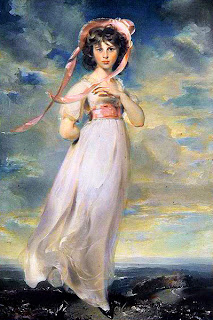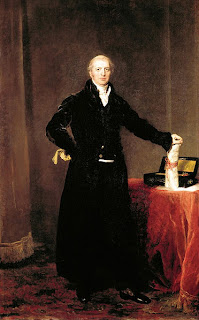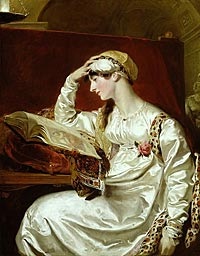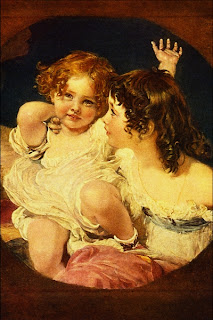Words fail me (Victoria here) when I try to describe how much I enjoyed seeing Thomas Lawrence: Regency Power and Brilliance in New Haven CT. Kristine wrote about the exhibition on this blog when it was in London at the National Portrait Gallery and Jo Manning did several follow-ups on Lawrence. But it’s pretty hard to prepare oneself for standing before a larger-than-life canvas in sparkling colors and knowing there are dozens more just outside your peripheral vision. To the right, Diane Gaston and I prepare to enter the Yale Center for British Art on a bright sunny day after a long drive from Washington, DC. Many thanks to our chauffeur cum photographer, Jim Perkins, Diane’s DH.
No pictures were allowed in the exhibition, but we asked if we could take one at the entrance and they said yes. Behind the entrance panel, you get a glimpse of two of the nearly-overwhelming portraits. Left is Lord Mountstuart, from a private collection, and on the right, the famous portrait of Elizabeth Farren, actress, later Countess of Derby. Diane and I had already been through the exhibition once or we could not have stood still long enough for the shot. Think we were excited? Oh, just a little!
John, Lord Mountstuart (1767-94) is a stunning example of raw masculinity that shocked some viewers (like the King!) when it was displayed at the Royal Academy in 1795. Like many of Lawrence’s portraits — if not all — the dramatic setting is enhanced by the exquisite detail and highlights of white, silver and pink. Lord Mountstuart stands on the edge of a precipice, with Spanish mountains and the Palace of Escorial in the background. Lawrence began this portrait before Mountstuart’s unexpected death at a young age.
Like several of the other portraits, I had visited before with Elizabeth Farren (1759-62-1829) in her usual home at New York’s Metropolitan Museum of Art. I want to put in a reminder here of the excellent novel about Miss Farren, the Earl of Derby (her eventual husband), Anne Damer, and other luminaries in the highest social circles of early 19th c. London, written by acclaimed novelist Emma Donoghue (author of the current best seller, Room). Entitled Life Mask, this is a fascinating fictional account of real people and their intertwined lives, some of it imagined, some of it factual. More details here.
Lawrence is at his best, carrying on in the tradition of Van Dyke, Gainsborough and others by painting the fabrics so realistically you think you could feel the satin if you touched it. I covet that muff, by the way.
Most commentators on Lawrence make a big point of the way he flattered his sitters, sometimes outrageously so, as in the portraits of George IV. But there were a few exceptions to his usual flattery in this exhibition. For example, the Portrait of Catherine Rebecca Grey, Lady Manners, later Lady Huntingtower (1766-1852). It is a fine portrait, with excellent details. But I would not say this straight on view of her face is particularly complimentary. Instead, she looks almost surprised to find us staring at her. The brightly colored peacock beside her draws the viewer’s attention away from her face. The fine sheer dress fabric is painted as realistically as Farren’s satin, puddling around her feet like a wispy little cloud. And the rose in her right hand is perfection.
I don’t mean to infer that she is not attractive, but only that a three-quarter view might have been much more flattering. That word again. This portrait belongs to the Cleveland Museum of Art, like many of the others on loan to this exhibition. Yale is the second and last venue for Thomas Lawrence: Regency Power and Brilliance, on view until June 5, 2011.
 |
| detail of Catherine Grey, Lady Manners
The other portrait I find less than flattering is this view of Robert Banks Jenkinson, later the 2nd Earl of Liverpool (1770-1828). Again, the head-on view does not compliment him. He seems to be frowning and his lip is slightly curled, almost as if beginning a sneer. This painting dates from 1793-96 when Lawrence was doing many statesmen and politicians, and flattering many of them. Another Lawrence picture (not in this exhibition) of Lord Liverpool done 33 years later, portrays him as less At right, Lord Liverpool in 1826 as Prime Minister, in the National Portrait Gallery (not in the Yale exhibition) Isabella Wolff and Thomas Lawrence remained dear friends for many years, and were sometimes suspected of being lovers. For more on Lawrence’s love life, go backward in this blog to Jo Manning’s essays on January 8, 9, and 10th, 2011. This is probably the first Thomas Lawrence canvas I saw as a child. At the Art Institute of Chicago, it was my favorite picture. Maybe it still is. As one of the reviews of the exhibition said, many of us became more than familiar with some Lawrence images because we saw them on biscuit tins and other ads or labels. Or in multiple prints, even paint-by-number sets.This charming view of a thoughtful (or bored) little boy is one of those biscuit tin portraits — you’ve seen it a million times, though you can’t remember quite where. This is Charles William Lambton, painted in 1825, now in a private collection. Charles was about seven in the portrait and he died just six years later at age thirteen. That gives a distinct poignant twist to this familiar face.
 Pinkie is a portrait of Sarah Barrett Moulton painted in 1794. It can be seen at the Huntington Library and Museum of Art in San Marino, CA. It is often shown with a Gainsborough portrait called Blue Boy. (Again, this picture is not in the Yale exhibition.) I actually think I’ve seen Pinkie on a tea towel. Pinkie is a portrait of Sarah Barrett Moulton painted in 1794. It can be seen at the Huntington Library and Museum of Art in San Marino, CA. It is often shown with a Gainsborough portrait called Blue Boy. (Again, this picture is not in the Yale exhibition.) I actually think I’ve seen Pinkie on a tea towel.To conclude part one of our visit to the exhibition, here is a lovely family group, another in Lawrence’s bravura style. The beautiful lady and her son, heir to a great title, with their faithful dog in a scene that will be a family heirloom forever. But wait!!! This is a portrait of Mrs. Frances Hawkins and her Son, John James Hamilton, painted in 1805-6. Diane Gaston and I want to thank Amy McDonald and Kaci Bayless for their assistance and hospitality at the Yale Center for British Art. Everyone was cheerful, helpful and welcoming. We wish we could have attended one of the many programs accompanying the exhibition. They are listed on-line if you click here. For more information on the exhibition, click here. I will be back with lots more about Thomas Lawrence: Regency Power and Brilliance in days to come. Remember, the closing date is June 5, so make your plans to visit New Haven soon. |





Let me tell you, Vicky was a wonderful person to tour the museum with. She knows all these gossipy details about the people in the portraits!!
I still wish I could go through the exhibit one more time….
You guys! You brought this exhibit back to life for me, thank you. Hester Davenport and I had such a wonderful time at the Royal Academy in London. And wasn't that some portrait of Lord Mountstuart?! Nothing like seeing it in person… 🙂
There is a great biography yet to be written about Sir Thomas Lawrence. So many unanswered questions there.